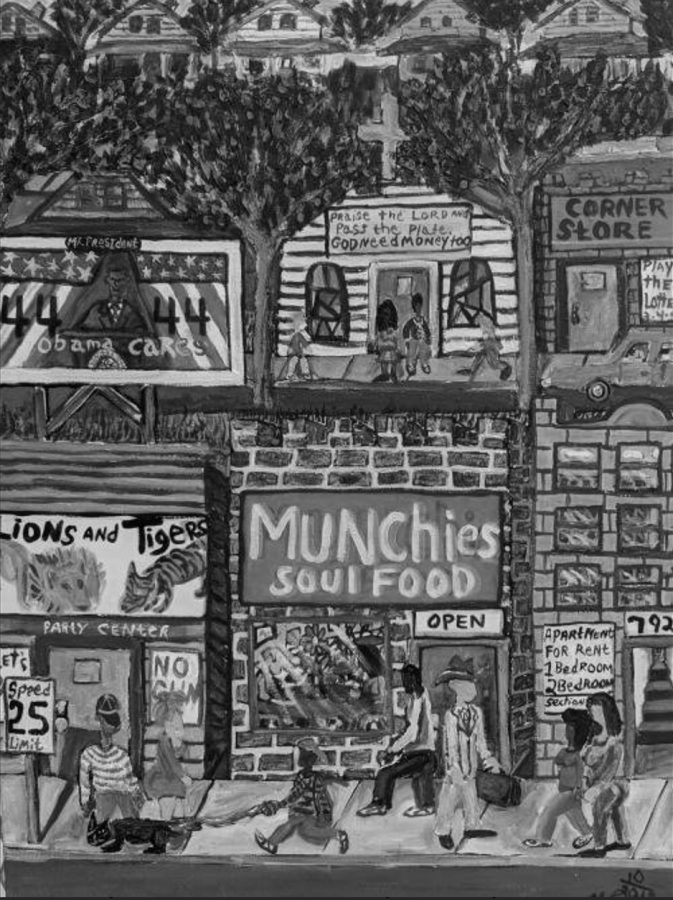AMAM Invites Local Musicians to Celebrate Shared Art Program Painting
Photo Courtesy of Allen Memorial Art Museum
Michelangelo Lovelace’s “These Urban City Streets” inspired Thursday’s performance at AMAM.
This Thursday, musicians from Oberlin and other areas of Northeast Ohio performed at the Allen Memorial Art Museum to conclude the year-long Shared Art program. In the courtyard behind the museum, the group of musicians debuted an original composition by Caleb Smith, OC ’19, inspired by this year’s shared artwork; “These Urban City Streets” by Cleveland-based artist Michelangelo Lovelace.
The Shared Art program started in 2021 as a way to introduce incoming students to the Allen and engage them in conversations around a piece of art in the museum’s collection. During orientation, first-year students look at and discuss the shared artwork in their PAL groups and attend the Shared Art Block Party hosted by the Allen, where they can enjoy snacks, crafts, and other activities while viewing the art and exploring the museum. Thursday’s event emerged from the Shared Art program organizers’ desire for another event to bookend the program and conclude the year-long conversation surrounding the work.
“We thought it’d be really fun and exciting to bring in some artists from the Cleveland area since Michelangelo Lovelace, the painter, was born and raised in Cleveland and lived his whole life in Cleveland,” Curatorial Assistant Julia Alexander, OC ’22, said. “So we were thinking, ‘What artist can we bring in?’ And then we kind of landed on music as something that’d be really exciting.”
According to Alexander and Curator of Academic Programs Hannah Wirta Kinney, featuring artists from Cleveland was important because the work, like much of Lovelace’s art, was centered around the city. ‘These Urban City Streets” colorfully depicts a bird’s-eye view of a Cleveland neighborhood, stressing both the vibrancy and the grittiness of the environment and community. The artwork chosen for the program always involves the theme of place and how it affects who people are and the art they create.
“Lovelace has this way of depicting Cleveland in a very honest and raw way but very lovingly,” Alexander said. “I think it really has opened up conversations on what is a hometown and especially for incoming first-years [because] they’re coming to a new place and suddenly Oberlin is their new home.”’
When Alexander reached out to Smith, who grew up in Cleveland, about finding local musicians, Smith said he would not only be willing to perform and assemble an ensemble, but he would also like to write a piece inspired by Lovelace’s work, which the Allen agreed to commission.
While composing, Smith said he listened to recordings of Lovelace, who died in 2021, to better understand Lovelace’s artistic process and the experiences that informed his work. Smith said he also focused on the textures in the artwork and tried to recreate that musically.
“A lot of [Lovelace’s] pieces you’ll see are kind of a bird’s-eye view,” Smith said. “He wanted to gather the entirety of the landscape. A lot of his pieces use rough things like sand and whatnot. So, [I was] thinking about music that spans a wide range of different textures. … You think about the basic textures involved with the piece and then you try to do that musically.”
Alexander and Kinney expressed that including both music and visual art was important to connect to different audiences. Kinney says she feels that the two art forms together can allow for greater engagement from everyone.
“I think when we bring in these different ways to get at questions or ideas that artists are grappling with, we can all find our own entry point,” Kinney said. “So maybe someone who knows how to listen to music much better than me can listen to that composition tomorrow and suddenly see something in the Michelangelo Lovelace that they never saw before. Or the alternative is, I look at the Michelangelo Lovelace, [while] I’m listening to this music, and I can suddenly be like, ‘Oh, so that sound, that rhythm, that pattern is what this is like in paint,’”
Given its accessibility to both music and visual art lovers, Kinney and Alexander said that they hoped that this event would attract people from all parts of the Oberlin community, including both community members, those affiliated with the College, as well as act to help connect Oberlin students to the greater Northeast Ohio region through the participation of local musicians. Alexander added a major goal was to make people feel comfortable in a museum setting.
“I think that it’s easy for the museum to be seen as a quiet space or a space that’s kind of one dimensional, a relationship between a viewer and an object,” Alexander said. “But I think that we’ve been trying to kind of turn that narrative on its head in a lot of ways. … So I think the multimedia approach that we’re trying to use is really just a way of making people feel really comfortable in the museum setting.”











